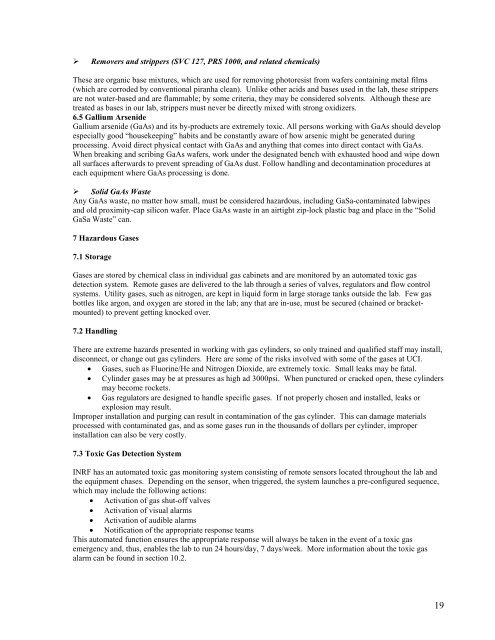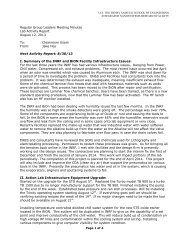Download Lab Safety Manual - Integrated Nanosystems Research ...
Download Lab Safety Manual - Integrated Nanosystems Research ...
Download Lab Safety Manual - Integrated Nanosystems Research ...
You also want an ePaper? Increase the reach of your titles
YUMPU automatically turns print PDFs into web optimized ePapers that Google loves.
‣ Removers and strippers (SVC 127, PRS 1000, and related chemicals)<br />
These are organic base mixtures, which are used for removing photoresist from wafers containing metal films<br />
(which are corroded by conventional piranha clean). Unlike other acids and bases used in the lab, these strippers<br />
are not water-based and are flammable; by some criteria, they may be considered solvents. Although these are<br />
treated as bases in our lab, strippers must never be directly mixed with strong oxidizers.<br />
6.5 Gallium Arsenide<br />
Gallium arsenide (GaAs) and its by-products are extremely toxic. All persons working with GaAs should develop<br />
especially good “housekeeping” habits and be constantly aware of how arsenic might be generated during<br />
processing. Avoid direct physical contact with GaAs and anything that comes into direct contact with GaAs.<br />
When breaking and scribing GaAs wafers, work under the designated bench with exhausted hood and wipe down<br />
all surfaces afterwards to prevent spreading of GaAs dust. Follow handling and decontamination procedures at<br />
each equipment where GaAs processing is done.<br />
‣ Solid GaAs Waste<br />
Any GaAs waste, no matter how small, must be considered hazardous, including GaSa-contaminated labwipes<br />
and old proximity-cap silicon wafer. Place GaAs waste in an airtight zip-lock plastic bag and place in the “Solid<br />
GaSa Waste” can.<br />
7 Hazardous Gases<br />
7.1 Storage<br />
Gases are stored by chemical class in individual gas cabinets and are monitored by an automated toxic gas<br />
detection system. Remote gases are delivered to the lab through a series of valves, regulators and flow control<br />
systems. Utility gases, such as nitrogen, are kept in liquid form in large storage tanks outside the lab. Few gas<br />
bottles like argon, and oxygen are stored in the lab; any that are in-use, must be secured (chained or bracketmounted)<br />
to prevent getting knocked over.<br />
7.2 Handling<br />
There are extreme hazards presented in working with gas cylinders, so only trained and qualified staff may install,<br />
disconnect, or change out gas cylinders. Here are some of the risks involved with some of the gases at UCI.<br />
• Gases, such as Fluorine/He and Nitrogen Dioxide, are extremely toxic. Small leaks may be fatal.<br />
• Cylinder gases may be at pressures as high ad 3000psi. When punctured or cracked open, these cylinders<br />
may become rockets.<br />
• Gas regulators are designed to handle specific gases. If not properly chosen and installed, leaks or<br />
explosion may result.<br />
Improper installation and purging can result in contamination of the gas cylinder. This can damage materials<br />
processed with contaminated gas, and as some gases run in the thousands of dollars per cylinder, improper<br />
installation can also be very costly.<br />
7.3 Toxic Gas Detection System<br />
INRF has an automated toxic gas monitoring system consisting of remote sensors located throughout the lab and<br />
the equipment chases. Depending on the sensor, when triggered, the system launches a pre-configured sequence,<br />
which may include the following actions:<br />
• Activation of gas shut-off valves<br />
• Activation of visual alarms<br />
• Activation of audible alarms<br />
• Notification of the appropriate response teams<br />
This automated function ensures the appropriate response will always be taken in the event of a toxic gas<br />
emergency and, thus, enables the lab to run 24 hours/day, 7 days/week. More information about the toxic gas<br />
alarm can be found in section 10.2.<br />
19



